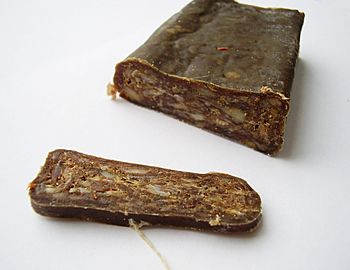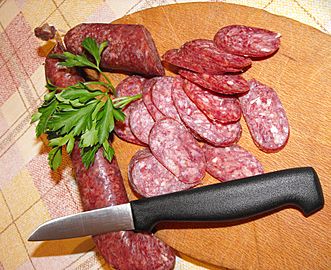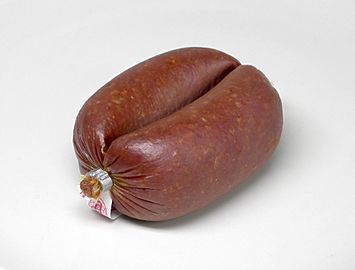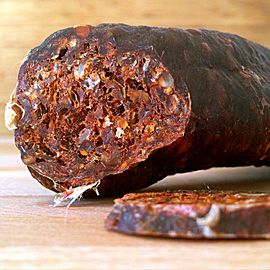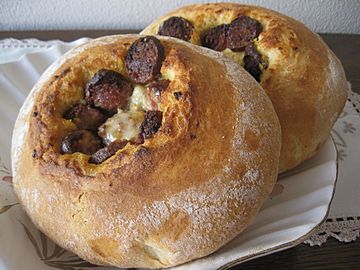Sujuk facts for kids
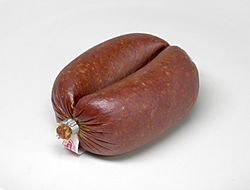
Turkish parmak sucuk
|
|
| Alternative names | Sucuk, suxhuk, sudjuk, sudžuk, sudzhuk |
|---|---|
| Type | Sausage |
| Region or state | Middle East, Central Asia, Balkans |
| Main ingredients | Ground meat (usually beef, lamb or horse meat), cumin, garlic, salt, red pepper |
Sujuk (also spelled sucuk) is a special kind of dry, spicy sausage. It's popular in many countries, especially in the Balkans, the Middle East, and Central Asia. Sujuk is made from ground meat, usually beef or lamb. Sometimes, horse meat is used, especially in places like Armenia, Bulgaria, Kazakhstan, and Kyrgyzstan. It's a fermented sausage, which means it goes through a special process that gives it its unique flavor and helps it last longer.
Contents
Where Does the Name Sujuk Come From?
The word sucuk has a long history. It was first written down in the 11th century in a book called Dīwān Lughāt al-Turk. Later, in the 14th century, another book mentioned it. The name might have come from old Persian words that meant "stretching" or "strip," like a long piece of meat.
Other countries in the region use similar names for this sausage. For example, in Kazakh, it's shujyq, and in Kyrgyz, it's chuchuk. The Turkish name sucuk has been adopted by many other languages, like Albanian (suxhuk), Arabic (sujuq), and Greek (sutzúki).
How is Sujuk Made?
Making sujuk is a careful process. In Turkey, beef is the main meat used. First, the meat is ground into small pieces. It's also checked to see how much fat it has.
Next, the meat is mixed with special curing salt. This salt helps preserve the meat. The mixture then rests for several hours in a cool place. After resting, the meat is mixed again. This time, frozen fat, like beef tallow, is added. Spices like cumin and red pepper are also mixed in, along with other ingredients like ascorbate and dextrose.
The mixture is ground one more time. This makes sure all the ingredients are well blended and gives sujuk its unique look. Finally, the mixture is put into special casings, which are like tubes. These casings are then twisted or tied to make individual sausages.
Ripening and Drying
After being shaped, sujuk goes through a ripening process. This involves two main steps: fermentation and post-fermentation.
- Fermentation: For the first few days, the sausages are kept in a warm, humid room. The temperature and humidity are slowly lowered each day. During this time, good bacteria help the sausage develop its flavor and texture.
- Post-Fermentation: After fermentation, the sujuk is matured and dried. This step removes moisture from the sausage. The drying continues until the sausage has less than 40% moisture. This makes it a dry sausage that can be stored for a long time.
- Different kinds of sujuk from various countries
-
Suǰux from Armenia
-
Sudzhuk from Bulgaria
-
Sucuk from Turkey
-
Home-made suxhuk from Kosovo
What's in Sujuk?
Sujuk is known for being rich in flavor and nutrients. On average, sujuk from Turkey contains about 24.5% protein. It also has about 31.5% fat and 3.80% salt. The amount of fat can change depending on the brand. Some sujuk might have less fat, around 23%, while others can have over 42%.
Eating Sujuk: Delicious Dishes
Sujuk is very versatile and can be used in many tasty dishes!
Popular Ways to Cook Sujuk
One common way to enjoy sujuk is to slice it thinly and pan-fry it with a little butter. Larger pieces can also be grilled.
A very popular breakfast dish in Turkey is Sucuklu yumurta. This means "eggs with sujuk." It's a simple dish where fried eggs are cooked right alongside slices of sujuk. Sujuk can also be added to other egg dishes, like menemen. Menemen is similar to shakshouka, but it uses scrambled eggs instead of poached eggs.
Sujuk in Other Meals
Sujuk isn't just for breakfast! It can be added to many different meals. You might find it in a bean stew called kuru fasulye. It's also used in phyllo dough pastries like burek. Some people even use sujuk as a topping for pizza or a flatbread called pide.
See also
 In Spanish: Sucuk para niños
In Spanish: Sucuk para niños


